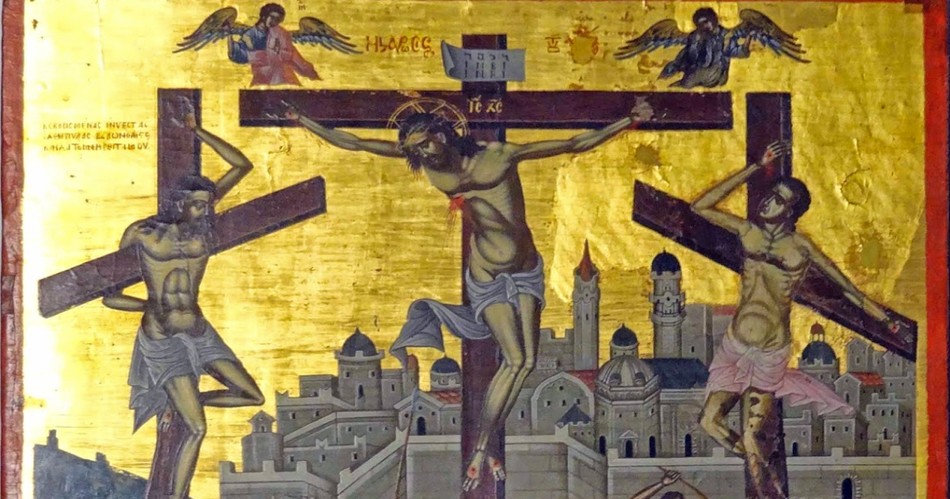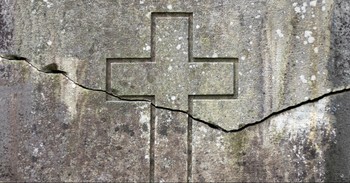After Jesus “yielded His spirit” and died on the cross, the Apostle John writes that one of the Roman soldiers took a spear and “pierced” Jesus side, “and immediately blood and water came out” (John 19:34). Understandably, the severe physical trauma suffered by Jesus on the cross and in the moments leading up to His death contributed to the catastrophic destruction of His physical body. By design, Roman scourging and crucifixion would have caused Jesus unbearable pain, leading to severe dehydration, blood loss, and ultimately, cardiorespiratory failure. However, in reading John’s account of the crucifixion, many may still wonder, why did blood and water flow from Jesus’ side and not just blood; and what is the spiritual significance of such a detail in the death of Jesus Christ?
Where in the Bible Does it Say Jesus Was Pierced in the Side on the Cross?
All four New Testament gospel accounts provide record of the trial, crucifixion, death, and burial of Jesus Christ on the day that became known as Good Friday (see Matthew 27:11-66; Mark 15:1-47; Luke 23:1-56; John 18:28-19:42). Although there are some variations and different details included (or left out) in each account, all four gospel writers agree on the key details of Christ’s death, burial, and resurrection.
The Apostle John, however, notes one specific detail about the moments immediately following Jesus’ death that the others, often referred to as the Synoptic Gospels, do not. He writes, “…but coming to Jesus, when they saw that He was already dead, they did not break His legs. But one of the soldiers pierced His side with a spear, and immediately blood and water came out” (John 19:34; emphasis added).
There is an important reason why John probably chose to include this graphic detail in his account of the crucifixion, which we will explore in a moment. However, John was able to include more specific and personal information about the final moments of Jesus’ life for one simple reason: He was there.
After Jesus was seized and arrested in the Garden of Gethsemane, Matthew tells us that “all the disciples left Him and fled” (Matthew 26:56; see also Mark 14:50). Sadly, Jesus’ closest friends and followers abandoned Him in His final hours. However, not all chose to flee.
In the gospels, we read that some of the women who had accompanied Jesus during His ministry followed the procession “at a distance” and remained at the foot of the cross when Jesus breathed His last (see Matthew 27:55-56; Mark 15:50-41; Luke 23:49). Only John writes of the woman being close enough to hear Jesus’ final words. This was something he alone could testify to as the only member of the Twelve at the cross when Jesus died.
Accordingly, the Apostle John would have been near enough to witness Jesus’ final moments, hear His final words, and observe the spear that pierced Jesus’ side shortly after He gave up His spirit and breathed His last (John 19:34). John writes, “he who has seen has testified, and his testimony is true; and he knows that he is telling the truth, so that you also may believe” (John 19:35).
Why Did the Romans Stab Jesus in the Side?
To ensure that Jesus was, in fact, dead, “one of the soldiers pierced His side with a spear” (John 19:34). This thrust, aimed at the heart and lungs, would have been fatal to anyone still living. The spear, however, only confirmed what the Roman soldiers already observed. Jesus was, in fact, already dead.
By most historical accounts, Roman crucifixion was designed to be one of the slowest and most painful forms of death imaginable. In some cases, the individual hanging on the cross may have suffered for up to nine days before eventually suffocating or dying from cardiac arrest or blood loss.
Needless to say, Jesus “endured” every pain and humiliation of Roman crucifixion as He willingly “laid down His life for His friends” (John 15:13; see also John 10:11-18; Hebrews 12:2). Furthermore, as Isaiah prophesied, “He was wounded for our transgressions, He was bruised for our iniquities; the chastisement of our peace was upon Him; and by His stripes we are healed” (Isaiah 53:5; see also 1 Peter 2:24; Philippians 2:5-11).
However, unlike some victims of Roman crucifixion, Jesus would not remain on the cross for days. In fact, Jesus had died in less time than most who were crucified, and not because He suffered less. It could be strongly argued that He actually suffered more. However, after accomplishing His divine mission, Jesus laid down His life of Himself, famously declaring, “It is finished!” before He breathed His last (see John 19:30).
Furthermore, John tells us that the Pharisees, who were the primary figures calling for Jesus’ crucifixion, wanted Jesus to die quickly and be taken down before the Sabbath started. This was in accordance with ceremonial law (see Deuteronomy 21:22-23).
Death in Roman crucifixion could, however, be expedited by breaking the legs of the victim, making it nearly impossible for him to raise himself and take a breath. Asphyxiation resulted within minutes.
Accordingly, the Pharisees called upon Pontius Pilate to have Jesus’ legs broken, hastening His death so that He could be removed from the cross and buried before sundown (John 19:31). However, when the soldiers went to break the legs of Jesus, “they saw that He was already dead.” As a result, none of Jesus’ bones were broken, which John highlights as a fulfillment of messianic prophecy regarding Christ as the final, unbroken Passover lamb, who died in our place and took upon Himself the fullness of God’s wrath for sin (Exodus 12:46; Numbers 9:12; Psalms 34:20).
Why Did Blood and Water Come out of Jesus’ Side?
When we add up the violent details of Jesus’ death provided in the gospels, we find that the most credible explanation for why blood and water flowed from His side when pierced is that the spear ruptured the fluid that had accumulated around His heart and lungs due to a lack of oxygen to the body.
The forensic details of Roman crucifixion have been well-documented over the centuries. To this day, there are few forms of torture that have been proven to be as slow, as painful, or as unbearable as crucifixion. It is where we get the term “excruciating.” Even in the first century, crucifixion was only reserved for the worst criminals, slaves, and revolutionaries of the Roman Empire.
Of course, the Romans were not the first to use crucifixion as a form of capital punishment. That unfortunate title belongs to the Persians of 300 – 400 B.C. However, throughout the first century, the Romans would come to perfect the art of crucifixion as one of the most violent and horrific forms of execution ever conceived. By the time Jesus was crucified, the Romans had become quite proficient and prolific at inflicting the maximum amount of pain on their intended victims.
In many ways, the historical descriptions of Roman crucifixion align with the details of Christ’s death provided in the gospels. Together, we are given some medical insight into the reason why blood and water flowed from His side when He was pierced.
To start, the gospels tell us that Jesus’ suffering began before He was ever crucified.
It was in the Garden of Gethsemane that Luke writes, “Being in agony He (Jesus) was praying very fervently; and His sweat became like drops of blood, falling down upon the ground” (Luke 22:44).
Modern medicine points to a rare but identifiable condition known as hematohidrosis as a possible explanation for Christ’s sweating blood. Under extreme physical, mental, or emotional stress (see Matthew 26:38), the capillary vessels that feed the sweat glands can rupture, causing blood to be released from the pores of the skin.
Therefore, before even being arrested, Jesus was already physically weakened by the anxiety and stress of knowing what lay ahead. His skin had also been made tender by the hematohidrosis.
Kept awake for the remainder of the night, Jesus was given little water, food, or chance to rest and recover as He traveled back and forth from the courtyard of the high priest to Pontius Pilate’s Praetorium, and then King Herod’s palace (Matthew 26:67-75; Mark 14:61-72; Luke 22:54-23:25; John 18:16-27).
In between each visit, Jesus was mocked, blindfolded, and brutally beaten by both Roman and Jewish guards, resulting in His eyelids likely swelling shut and the severe disfigurement of His face (see Isaiah 52:13-14; Luke 22:63-65). Accordingly, by the time the morning came, Jesus would have been marred beyond recognition.
Pontius Pilate then ordered Jesus to be scourged (flogged) as required by Roman law prior to crucifixion (Matthew 27:26-32; Mark 15:15-21; Luke 23:25-26; John 19:1-28).
Most historical accounts confirm that, in such cases, the accused would be stripped naked and flogged from his shoulders down to his upper legs using a whip made with long strips of leather. In most instances, metal balls, strips of glass, and sheep bone were tied to the leather strips, resulting in tremendous bruising, deep lacerations, and the tearing of chunks of flesh from the victim’s body wherever the whip made contact.
Having suffered no less than thirty-nine lashes, Jesus’ skin would have been torn and shredded, exposing His muscles and, in some places, skeletal structure.
Not surprisingly, many victims did not survive such an extreme and severe form of punishment. Those who did were left severely dehydrated and weakened by the resulting loss of blood. It was not uncommon for many to go into hypovolemic shock as the body reacted to the sudden drop in blood pressure.
After the scourging, we read that the Romans continued to beat Jesus. They then placed a robe on His back (Matthew 27:28-29) and fashioned a mocking crown of thorns, which they mercilessly pressed into His skull (Matthew 27:30).
The robe, which temporarily helped Jesus’ blood clot, was later ripped off of His back, reopening every wound and causing blood to pour from His back once again.
The crown of thorns, made of long, thick spikes, had been pressed and beaten into Jesus’ head and face, causing what remaining blood He had left to pour profusely down His face.
Accordingly, Jesus was already in critical condition, having lost so much blood without replenishment.
Severely dehydrated, in hypovolemic shock, and entering the early stages of cardiorespiratory and kidney failure, Jesus was then given a heavy wooden beam (often 75-100 pounds) and commanded to bear His cross through the streets of Jerusalem to the hill of Golgotha where He would eventually be crucified.
Understandably, Jesus was barely able to stand, let alone walk several miles while carrying a heavy beam on His shoulders. For this reason, the Roman soldiers ordered Simon of Cyrene to carry the horizontal portion of Jesus’ cross the rest of the way (Matthew 27:32).
Having reached the hill just outside of Jerusalem, Jesus was then nailed to the cross via His hands (at the wrists) and feet by massive seven to nine-inch-long nails that permanently severed vital nerves in both His wrists and ankles. Once elevated, Jesus would then have to endure the agonizing pain of every breath.
By design, Jesus’ outstretched arms and shoulders would eventually dislocate under the weight of having to hold up His entire body. Here, all His body weight would have then transferred to His chest, forcing Him to push down on His feet to allow His rib muscles to relax and let out a breath.
However, as Jesus was already severely dehydrated (see John 19:28) and in a state of hypovolemic shock, not to mention exhausted from all of the walking, beatings, and lack of sleep, food, or water, He, like many, would have had little energy to bear Himself up on His legs, making every breath an agonizing and difficult effort.
Here, Jesus’ blood oxygen levels would have already begun to decrease as his blood carbon dioxide levels increased to dangerous levels. In response, His heart would have had to beat even faster to meet His body’s unmeetable oxygen demand. After only a few hours, Jesus’s lungs would have begun to collapse, and His heart would have begun to fail.
Consequentially, the damaged tissues and capillaries of Jesus’ body would have started to leak fluid from the blood into the tissues, resulting in a build-up of fluid around the heart (pericardial effusion) and lungs (pleural effusion). This explains, therefore, the blood and water that poured from Jesus’ side when His heart and lungs were pierced by the Roman soldier’s spear.
In any case, most victims of crucifixion eventually died from a slow form of suffocation. In other cases, a decrease in oxygen to the blood, paired with the resulting complications, can damage the heart itself, leading to cardiac arrest. In severe cases, the heart can even rupture. It is likely, therefore, that Jesus died from a combination of suffocation, blood loss, dehydration, and cardiac arrest.
What Does the Blood and Water from Jesus’ Side Symbolize?
The spear thrust into Jesus’ side through the lungs and heart would have ensured the death of anyone hanging upon the cross. Given the vital organs pierced, this was not a wound one could have recovered from. John includes this detail as another piece of physical evidence that Jesus had certainly died on the cross, putting to rest any theory that He may have somehow survived Roman crucifixion, recovered from His wounds, and later appeared to His followers, a theory that may have begun to circulate by skeptics in and around the time John sat down to write his gospel.
In any case, the apostle whom Jesus loved put pen to paper not just to provide a written account of the life and ministry of Jesus Christ; he also wanted to affirm the character and divinity of Jesus and testify that He was, in fact, who He said He was. Challenging any theory designed to disprove or dismiss the death and resurrection of Jesus was, therefore, essential.
However, while there is a forensic explanation for the blood and water that flowed from Jesus’ side when He was pierced, there is also a deeply spiritual significance to this event.
For one thing, when it came to the spear that pierced Jesus’ side, John again draws our attention to the messianic prophecy that states, “I will pour out on the house of David and on the inhabitants of Jerusalem, the Spirit of grace and of supplication, so that they will look on Me whom they have pierced; and they will mourn for Him, as one mourns for an only son, and they will weep bitterly over Him like the bitter weeping over a firstborn. In that day there will be great mourning in Jerusalem” (Zechariah 12:10-14; emphasis added).
Some, in repentance, will look upon Jesus and mourn for their sins; others, like the Pharisees, will look upon the one they have crucified and mourn, knowing they will be judged for their sins and their ultimate refusal to repent before the Son of God.
However, renowned commentator Matthew Henry offers another insight into the spiritual significance of Christ’s body. “The blood and water that flowed out,” he writes, “signified those two great benefits which all believers partake of through Christ, justification and sanctification, blood for atonement, water for purification. They both flow from the pierced side of our Redeemer. To Christ crucified we owe merit for our justification, and Spirit and grace for our sanctification.”
Thanks be to Christ for the pain and suffering He endured for our sake, so that we might be saved through the shedding of His precious blood.
Additional Resources:
“Why Was Jesus Pierced and Wounded for Our Transgressions?”
“What is the Meaning and Importance of Jesus’ Crown of Thorns?”
“What Old Testament Prophecies Predicted Jesus and the Cross?”
“Why is the Blood of Christ Necessary for Holy Living?”
“Why Did Jesus Have to Suffer so Badly?”
Photo credit: Public Domain




